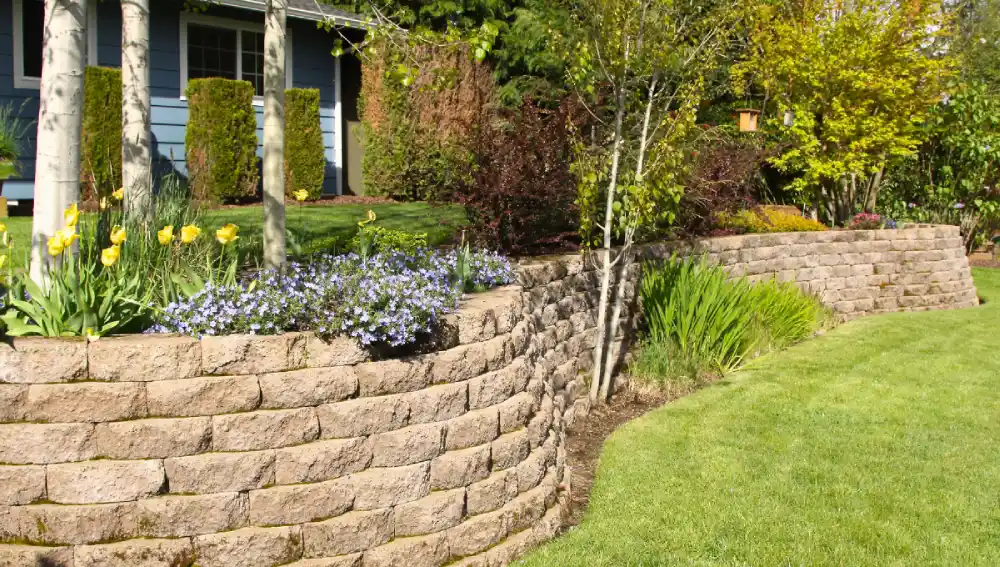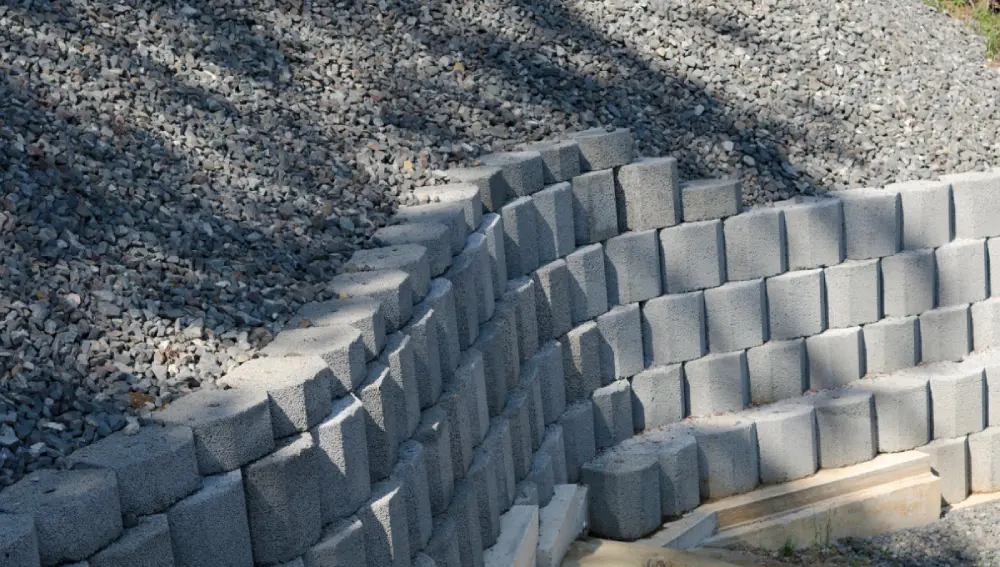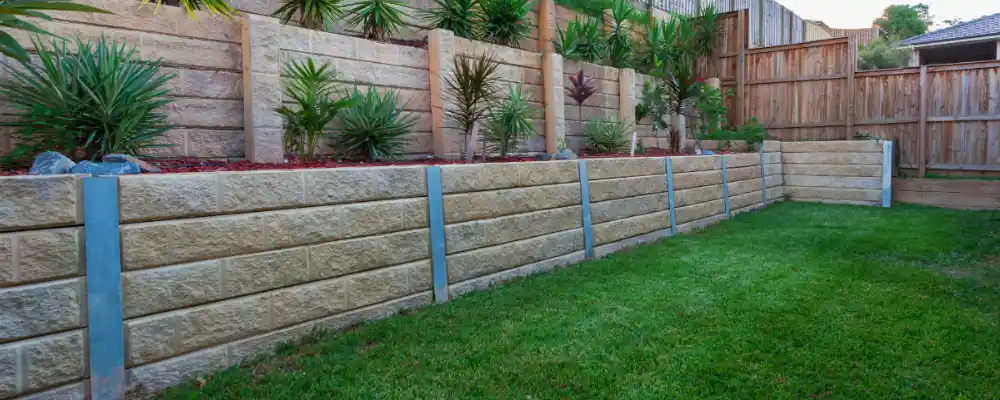A retaining wall is constructed to prevent the pressure of water, sand, or soil being pushed against it in order to support soil or other materials. These walls are available in a variety of styles and serve a variety of functions, including levelling slopes and stopping soil erosion. Both residential and commercial buildings use it because it provides stability and enhances aesthetic appeal.
This blog provides information on the many kinds of retaining walls, their attributes, benefits, and drawbacks.
- 1 Types of Retaining Walls Based on Shape and Function:
- 2 1. Gravity Retaining Walls
- 3 2. Cantilever Retaining Walls
- 4 3. Counterfort Retaining Walls
- 5 4. Anchored Retaining Walls
- 6 Types of Retaining Walls Based on Material Used:
- 7 Sheet Pile Retaining Walls
- 8 Geosynthetic Reinforced Retaining Walls
- 9 Earthen Walls with Mechanical Stabilization (MSE)
- 10 Concrete Retaining Walls
- 11 Masonry Retaining Walls
- 12 Gabion Retaining Walls
- 13 Hybrid retaining walls
- 14 Conclusion
- 15 FAQs
Types of Retaining Walls Based on Shape and Function:

1. Gravity Retaining Walls
Gravity retaining walls rely on their mass to resist lateral earth pressure from the soil behind them, preventing toppling and sliding. They are among the simplest types of retaining walls, designed with a wider base and sloped faces to handle higher pressures at greater depths. These walls use their substantial weight to counteract soil pressure.
Materials Used:
Common materials include concrete, stone, brick, and masonry blocks. Each material contributes to the wall’s mass and stability, with concrete and stone being particularly durable for larger structures.
Advantages:
- Simple construction with minimal reinforcement.
- Aesthetic flexibility with various materials and designs.
- Suitable for a wide range of heights and conditions.
Disadvantages:
- Requires substantial space due to the thickness needed for stability.
- Material and construction costs can be high.
- Not ideal for extremely tall walls without additional reinforcement.
Applications and Suitable Conditions:
They can be used for low-height to moderate-height applications in soil retention and landscaping, mainly if there is limited space. For heights exceeding 3 metres, alternative solutions or composite wall systems may be more appropriate.
2. Cantilever Retaining Walls
Cantilever retaining walls consist of a vertical stem and a base slab, designed to convert horizontal earth pressures into vertical forces on the ground. They typically feature a thin stem and leverage the weight of the retained soil for stability. These walls are generally constructed from reinforced concrete, making them suitable for higher walls compared to gravity walls.
The main components are the stem, toe, and heel. The stem is the vertical part, the toe extends in front of the stem, and the heel extends behind it, providing support and stability.
Materials Used:
Cantilever walls are constructed from,
- Reinforced Concrete,
- Precast Concrete,
- Prestressed Concrete
Advantages:
- Requires less material compared to gravity walls for the same height.
- Can be constructed for greater heights.
- More efficient use of space with a thinner wall profile.
Disadvantages:
- Requires skilled labour and careful design.
- Higher initial cost due to the use of reinforced concrete.
- The complex construction process needs formwork and reinforcement.
Applications and Suitable Conditions:
Cantilever retaining walls are ideal for supporting higher loads in areas with firm soil, commonly used in highway construction, basements, and other civil engineering projects.
3. Counterfort Retaining Walls
Counterfort retaining walls have vertical support structures that are attached to them and provide additional lateral earth resistance. They are mainly designed to withstand high loads and to reduce the shear force and bending moments.
Structural Components
- Counterforts: Diagonal braces that connect the stem to the heel, reducing the wall’s bending stress.
- Stem, Toe, Heel: Similar to the components of cantilever walls, with the addition of counterforts.
Materials Used
Common materials include reinforced concrete, stone, and brick.
Advantages:
- Reduced bending moments in the wall, allowing for taller structures.
- Efficient use of materials with the additional support from counterforts.
- Suitable for high walls with significant lateral pressure.
Disadvantages:
- Complex design and construction process.
- Higher initial cost due to additional materials and labour.
- Requires precise engineering and skilled labour.
Applications and Suitable Conditions:
Ideal for supporting high loads in large infrastructure projects, such as highways, bridges and large retaining structures where significant lateral earth pressure is present. Suitable for areas with firm soil and high retaining requirements.
4. Anchored Retaining Walls
Anchored retaining walls are reinforced with cables or similar elements to stay anchored into the soil or rock behind them. Anchors are driven deep into the ground and expanded, often using pressurised concrete to form a bulb, providing extra strength. Common anchors include soil nails, tensioned cables and rock anchors.
Materials Used:
Typically constructed from steel and concrete.
Advantages:
- Suitable for very high walls and areas with significant lateral pressure.
- Provides additional support in unstable soil conditions.
- Can be used in combination with other retaining wall types.
Disadvantages:
- Complex design and construction process.
- High initial cost due to the use of specialised materials and labour.
- Requires regular maintenance and monitoring.
Applications and Suitable Conditions:
Ideal for areas with limited space, high load requirements, or loose soil over rock. Commonly used in gardens, building sites, and slope stabilisation projects.
Types of Retaining Walls Based on Material Used:

Sheet Pile Retaining Walls
Sheet pile retaining walls are used in soft soil and tight spaces. They consist of interlocking sheets driven into the ground, typically one-third above ground and two-thirds below. Taller walls may require tie-back anchors for additional stability.
Materials Used:
Common materials include,
- Steel,
- Vinyl,
- Aluminium,
- Fibreglass,
- Wood.
Advantages:
- Can be used in places that have limited space and that are difficult to excavate.
- Quick and easy installation with minimal site disturbance.
- Versatile and can be used for temporary or permanent structures.
Disadvantages:
- Limited height and load capacity compared to other retaining wall types.
- They may be damaged in harsh situations and are susceptible to erosion.
- Stability can be achieved only by proper design and installation.
Applications and Suitable Conditions:
Ideal for waterfront structures, riverbank protection, cofferdams, and temporary excavation supports. Suitable for environments requiring quick and effective soil retention.
Geosynthetic Reinforced Retaining Walls
Geosynthetic reinforced retaining walls help in improving soil stability and stiffness by using materials like geogrids and geotextiles. They can accommodate greater loads and steeper angles, providing flexibility compared to traditional concrete walls.
Types of Geosynthetic Materials:
- Geogrids: gives high tensile strength and durability.
- Geotextiles: Improve chemical and biological resistance, and help hold aggregates together.
Advantages:
- Helps in the construction of tall and stable walls.
- Reduces the need for heavy and expensive construction materials.
- Provides flexibility in wall design and construction.
Disadvantages:
- Requires specialised materials and construction techniques, which are often expensive.
- Stability can be achieved only by proper design and installation.
- They can be damaged by improper installation and environmental conditions.
Applications and Suitable Conditions:
They can be applied to narrow spaces, roadways, and steep inclines. They are most appropriate for locations requiring earthquake resistance and moderate to high load bearing capacity. Places such as roadways, airport runways, and bridges can benefit from the use of geosynthetic reinforced retaining walls.
Earthen Walls with Mechanical Stabilization (MSE)
MSE walls are composite constructions supported by the soil reinforcement and compacted backfill placed alternately. They are flexible, stable, and capable of supporting heavy loads.
Materials Used:
Precast Concrete: For facing units, offering durability and aesthetic options.
Metallic Strips: Usually galvanised steel for reinforcement, providing high tensile strength and durability.
Advantages:
- Allows for the construction of tall and stable walls.
- Reduces the need for heavy and expensive construction materials.
- Provides flexibility in wall design and construction.
Disadvantages:
- Requires specialised materials and construction techniques.
- Requires careful engineering and suitable backfill.
- They are vulnerable to corrosion in reinforcements.
Applications and Suitable Conditions:
These walls are suitable for places that need high load-bearing and seismic resistance such as highways, bridge abutments, and seawalls. They can also be used for steep slopes and variable site conditions.
Concrete Retaining Walls
Concrete retaining walls are strong structures that are made to hold back the soil or other materials. They can be reinforced with steel for the addition of strength. Concrete walls are mostly made from concrete blocks or poured concrete.
Types
There are different types of concrete retaining walls like gravity walls, cantilevered walls, counterfort walls, and also precast walls. All these retaining walls have different functions like providing stability, pressure resistance, tall structure support, fast installation, and so on.
Applications
Concrete retaining walls can be used in large projects like commercial buildings and places that need a high load-bearing capacity. Some applications are industrial sites, highways, and landscaping.
Advantages and Disadvantages
These walls are strong and durable. They can be molded into different shapes that can be suitable for various designs. But they are costly to install. They may crack over time and skilled professionals are needed for proper construction.
Maintenance
They have a long life but need regular inspection and maintenance for proper structural integrity and to address problems like erosion or cracks.
Masonry Retaining Walls
Masonry retaining walls are built using materials like stones, bricks, and concrete blocks. They support soil and protect it from landslides or erosion depending upon their mass and structural integrity.
Types
- Dry-stacked
- Mortared walls
Applications
These types of walls are effective for residential landscaping as the visual appeal is important. They are also used in garden terraces and construction that need moderate height and load-bearing capacity.
Advantages
One of the main advantages of masonry retaining walls is the aesthetics. They provide various designs that help the customers to personalise and align according to the landscape. These walls are easy to repair and the individual bricks or stones can be replaced without disturbing the complete structure.
Disadvantages
The main disadvantage of these walls is their limitation of height. They are not good for tall structures and areas that have significant soil pressure. Also if it is not properly constructed these walls may shift or settle over time. So there is a need for skilled professionals to build this wall as there is a need for precision for long-term stability.
Gabion Retaining Walls
Gabion retaining walls are mainly composed of wire mesh cages that are filled with rocks, stones, or other materials. These cages will be placed to form a wall with the help of their weight under the interlocking nature of the materials that provide stability. They are flexible and the material choice of the walls will make them suitable for various applications.
Applications
These walls are effective for controlling erosion so it is used in rural as well as industrial environments. They can be used in riversides, highways, and other areas that are susceptible to erosion. These walls are also famous for their landscaping design because of their rustic appearance and advantage over the environment.
Advantages and Disadvantages
These walls are cost-efficient and easy to install. They do not need more foundation work and are also permeable, which helps in decreasing the pressure built up. Additionally, eco-friendly and locally available materials can be used for their construction.
As these walls are made from locally available materials, they may have some aesthetic limitations. Also, the wire mesh can rest or corrode after some time if they are in a moisture-filled environment. This may not be suitable for tall structures and high load-bearing capacity constructions.
Hybrid retaining walls
Hybrid retaining walls use both mass and reinforcement for stability. It combines the materials of various retaining wall styles. They offer flexibility and improved performance by optimising both functionality and aesthetics.
Combination of Different Retaining Wall Types:
These walls integrate elements from various systems, such as concrete panels with geosynthetic reinforcements, to enhance strength and stability while reducing material usage and construction time.
Design and Construction Considerations:
Hybrid walls require careful planning to balance different materials and methods. The design must address site-specific conditions, including soil type and load requirements, ensuring proper integration of various components.
Advantages:
Cost-effective, stronger and more stable, eco-friendly, flexible design, reduced build time, lower carbon footprint.
Disadvantages:
Complex design and construction, potentially higher costs, durability issues in harsh weather, expensive maintenance, limited expertise, and possible drainage problems.
Applications and Suitable Conditions:
Ideal for sloped terrains, high-load applications, and projects needing aesthetic versatility. Suitable where traditional walls are insufficient, offering tailored solutions for diverse engineering challenges.
Conclusion
Retaining walls are essential for soil management and slope stabilisation. Different types offer various benefits, from gravity walls for simplicity to hybrid walls for flexibility. This blog covers various types, from gravity walls to hybrid designs, highlighting their materials, advantages, and limitations. Whether you need a simple gravity wall or a complex hybrid design, understanding these options helps in making an informed decision.
FAQs
Counterfort retaining walls feature vertical supports that connect to the wall to resist lateral earth pressure and reduce bending stress.
Anchored retaining walls are suitable for very high walls or unstable soil conditions, reinforced with cables or stays.
Typically constructed from steel and concrete.
They are flexible, stable, and capable of supporting heavy loads with reduced material needs.
Hybrid retaining walls are ideal for projects needing high load capacity, aesthetic versatility, and tailored solutions.

